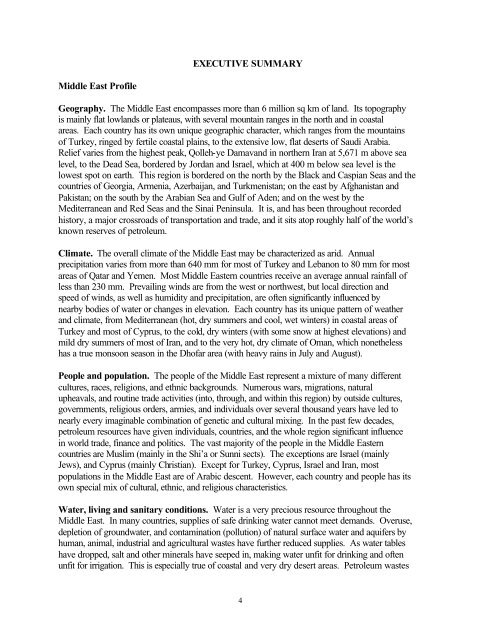Middle East DVEP - Armed Forces Pest Management Board
Middle East DVEP - Armed Forces Pest Management Board
Middle East DVEP - Armed Forces Pest Management Board
Create successful ePaper yourself
Turn your PDF publications into a flip-book with our unique Google optimized e-Paper software.
EXECUTIVE SUMMARY<strong>Middle</strong> <strong>East</strong> ProfileGeography. The <strong>Middle</strong> <strong>East</strong> encompasses more than 6 million sq km of land. Its topographyis mainly flat lowlands or plateaus, with several mountain ranges in the north and in coastalareas. Each country has its own unique geographic character, which ranges from the mountainsof Turkey, ringed by fertile coastal plains, to the extensive low, flat deserts of Saudi Arabia.Relief varies from the highest peak, Qolleh-ye Damavand in northern Iran at 5,671 m above sealevel, to the Dead Sea, bordered by Jordan and Israel, which at 400 m below sea level is thelowest spot on earth. This region is bordered on the north by the Black and Caspian Seas and thecountries of Georgia, Armenia, Azerbaijan, and Turkmenistan; on the east by Afghanistan andPakistan; on the south by the Arabian Sea and Gulf of Aden; and on the west by theMediterranean and Red Seas and the Sinai Peninsula. It is, and has been throughout recordedhistory, a major crossroads of transportation and trade, and it sits atop roughly half of the world’sknown reserves of petroleum.Climate. The overall climate of the <strong>Middle</strong> <strong>East</strong> may be characterized as arid. Annualprecipitation varies from more than 640 mm for most of Turkey and Lebanon to 80 mm for mostareas of Qatar and Yemen. Most <strong>Middle</strong> <strong>East</strong>ern countries receive an average annual rainfall ofless than 230 mm. Prevailing winds are from the west or northwest, but local direction andspeed of winds, as well as humidity and precipitation, are often significantly influenced bynearby bodies of water or changes in elevation. Each country has its unique pattern of weatherand climate, from Mediterranean (hot, dry summers and cool, wet winters) in coastal areas ofTurkey and most of Cyprus, to the cold, dry winters (with some snow at highest elevations) andmild dry summers of most of Iran, and to the very hot, dry climate of Oman, which nonethelesshas a true monsoon season in the Dhofar area (with heavy rains in July and August).People and population. The people of the <strong>Middle</strong> <strong>East</strong> represent a mixture of many differentcultures, races, religions, and ethnic backgrounds. Numerous wars, migrations, naturalupheavals, and routine trade activities (into, through, and within this region) by outside cultures,governments, religious orders, armies, and individuals over several thousand years have led tonearly every imaginable combination of genetic and cultural mixing. In the past few decades,petroleum resources have given individuals, countries, and the whole region significant influencein world trade, finance and politics. The vast majority of the people in the <strong>Middle</strong> <strong>East</strong>erncountries are Muslim (mainly in the Shi’a or Sunni sects). The exceptions are Israel (mainlyJews), and Cyprus (mainly Christian). Except for Turkey, Cyprus, Israel and Iran, mostpopulations in the <strong>Middle</strong> <strong>East</strong> are of Arabic descent. However, each country and people has itsown special mix of cultural, ethnic, and religious characteristics.Water, living and sanitary conditions. Water is a very precious resource throughout the<strong>Middle</strong> <strong>East</strong>. In many countries, supplies of safe drinking water cannot meet demands. Overuse,depletion of groundwater, and contamination (pollution) of natural surface water and aquifers byhuman, animal, industrial and agricultural wastes have further reduced supplies. As water tableshave dropped, salt and other minerals have seeped in, making water unfit for drinking and oftenunfit for irrigation. This is especially true of coastal and very dry desert areas. Petroleum wastes4

















